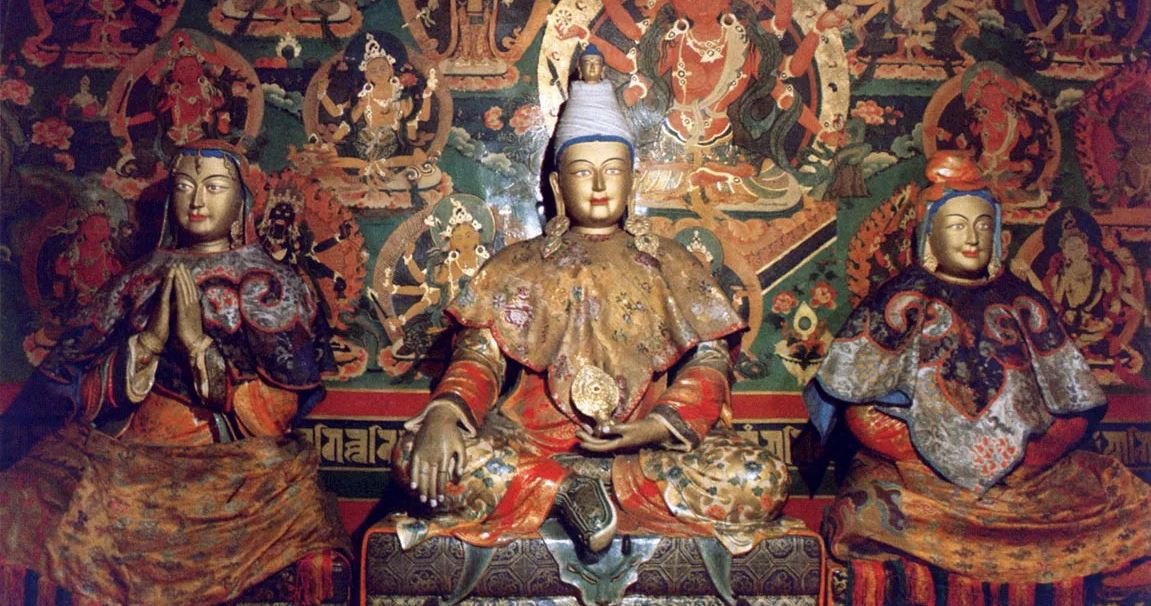The Life of Tibetan King Songtsen Gampo
Introduction
King Songtsen Gampo (reigned 618–649 CE) is one of the most revered figures in Tibetan history, celebrated as a visionary leader who unified Tibet and laid the foundations for its cultural and religious transformation. His reign marked the emergence of Tibet as a formidable power in Central Asia and the establishment of Buddhism as a central element of Tibetan culture. This essay explores the life of Songtsen Gampo, his achievements, and his enduring legacy.
Early Life and Ascension to the Throne
Songtsen Gampo was born around 617 CE, the exact date of his birth being uncertain, into the Yarlung dynasty, which ruled the Yarlung Valley in Central Tibet. His father, Namri Songtsen, was the ruler of the Yarlung kingdom and played a crucial role in expanding its territories. Namri Songtsen’s efforts laid the groundwork for the unification of various Tibetan tribes under a single ruler.
Following the assassination of Namri Songtsen, Songtsen Gampo ascended to the throne at a young age, around 618 CE. His early reign was marked by efforts to consolidate power and secure the stability of his kingdom. Despite his youth, Songtsen Gampo demonstrated remarkable leadership qualities, uniting the various warring factions and expanding the influence of his kingdom.
Unification of Tibet
One of Songtsen Gampo’s most significant achievements was the unification of Tibet. Before his reign, Tibet was fragmented into numerous tribes and small kingdoms, often engaged in conflict with one another. Songtsen Gampo embarked on a series of military campaigns and diplomatic initiatives to bring these disparate entities under his control.
His strategic prowess and diplomatic acumen enabled him to forge alliances and subdue rival tribes, gradually extending his authority over the Tibetan Plateau. By the mid-7th century, Songtsen Gampo had succeeded in unifying Tibet, establishing the foundations of the Tibetan Empire. This unification was a pivotal moment in Tibetan history, providing the stability necessary for the subsequent cultural and religious developments that would shape the region’s identity.
Establishment of the Tibetan Empire
With the unification of Tibet, Songtsen Gampo established the Tibetan Empire, transforming his kingdom into a formidable political and military power in Central Asia. His empire extended beyond the borders of present-day Tibet, encompassing parts of what are now China, India, Nepal, and Bhutan.
Songtsen Gampo’s reign was characterized by significant administrative and military reforms aimed at consolidating his power and securing the stability of his empire. He established a centralized administration, with officials appointed to govern different regions of the empire. This administrative structure allowed for more efficient governance and helped to integrate the diverse regions under his rule.
In addition to his administrative reforms, Songtsen Gampo also focused on strengthening the military capabilities of his empire. He organized a powerful army, equipped with advanced weaponry and trained in sophisticated military tactics. This military strength enabled Tibet to defend its borders and assert its influence over neighboring regions.
Diplomatic Relations and Marriage Alliances
Songtsen Gampo’s reign was marked by a series of important diplomatic initiatives, particularly his strategic marriage alliances, which played a crucial role in enhancing Tibet’s political and cultural influence. These alliances helped to secure Tibet’s borders, foster trade, and facilitate cultural exchange.
One of the most significant of these alliances was Songtsen Gampo’s marriage to Princess Bhrikuti Devi of Nepal. This marriage alliance strengthened the ties between Tibet and Nepal, promoting the exchange of culture, religion, and technology between the two regions. Princess Bhrikuti Devi is credited with bringing important cultural and religious influences to Tibet, including the introduction of Buddhist iconography and architectural styles.
Another pivotal marriage alliance was Songtsen Gampo’s union with Princess Wencheng of China. This marriage, arranged as part of a peace treaty with the Tang dynasty, was a significant diplomatic achievement. Princess Wencheng brought with her a retinue of Chinese artisans, scholars, and Buddhist texts, which had a profound impact on Tibetan culture and the development of Buddhism in Tibet.
Introduction and Promotion of Buddhism
One of Songtsen Gampo’s most enduring legacies is his role in the introduction and promotion of Buddhism in Tibet. Before his reign, Tibet was predominantly influenced by indigenous shamanistic and animistic religious practices. However, Songtsen Gampo recognized the potential of Buddhism to unify and culturally enrich his kingdom.
The influence of his queens, Princess Bhrikuti Devi and Princess Wencheng, was instrumental in this regard. Both queens were devout Buddhists and played a key role in promoting Buddhist teachings and practices within the Tibetan court. They encouraged the construction of Buddhist temples and the translation of Buddhist texts into Tibetan.
Under Songtsen Gampo’s patronage, several important Buddhist temples were constructed, including the Jokhang and Ramoche temples in Lhasa. These temples became major centers of Buddhist worship and learning, attracting scholars and practitioners from across the region.
Historical Context and Significance of King Songtsen Gampo's Reign
To fully appreciate the significance of Thonmi Sambhota’s work, it is essential to understand the broader historical context of King Songtsen Gampo’s reign. Songtsen Gampo is regarded as one of Tibet’s most important historical figures, and his reign marked a period of significant political and cultural transformation.
Songtsen Gampo is credited with unifying the various Tibetan tribes and establishing the Tibetan Empire as a formidable political entity. He implemented a series of reforms aimed at modernizing the state and consolidating his power. These reforms included the establishment of a centralized administrative system, the construction of monumental architecture (such as the Jokhang Temple in Lhasa), and the promotion of Buddhism as a unifying cultural and spiritual force.
One of Songtsen Gampo’s key strategies for achieving these goals was the adoption and adaptation of foreign knowledge and technologies. This included sending envoys and scholars to neighboring civilizations, such as China and India, to learn from their advanced cultures. Thonmi Sambhota’s mission to India and his subsequent creation of the Tibetan script can be seen as part of this broader initiative.
The Creation of the Tibetan Script
In addition to his contributions to the spread of Buddhism, Songtsen Gampo also played a crucial role in the development of the Tibetan written language. Recognizing the importance of a written script for the administration of his empire and the preservation of religious teachings, he sent a group of young scholars, including Thonmi Sambhota, to India to study Sanskrit and learn about the Indian writing systems.
Upon their return, Thonmi Sambhota developed the Tibetan script, based on the Devanagari script used for writing Sanskrit. This new script enabled the accurate transcription of the Tibetan language and facilitated the translation of Buddhist texts from Sanskrit into Tibetan. The creation of the Tibetan script was a monumental achievement, laying the foundation for Tibetan literature, religious texts, and administrative records.
Cultural and Architectural Contributions
Songtsen Gampo’s reign also saw significant cultural and architectural developments. The construction of the Jokhang Temple in Lhasa, considered the holiest temple in Tibetan Buddhism, stands as a testament to his architectural vision and religious devotion. The Jokhang Temple, along with other religious structures built during his reign, played a crucial role in the cultural and spiritual life of Tibet.
In addition to religious architecture, Songtsen Gampo’s court became a center of cultural exchange, attracting scholars, artists, and craftsmen from neighboring regions. This cultural exchange enriched Tibetan art, literature, and technology, laying the foundation for a vibrant and diverse Tibetan cultural heritage.
Legacy and Historical Significance
King Songtsen Gampo’s legacy is enduring and multifaceted. He is remembered as the unifier of Tibet, the founder of the Tibetan Empire, and a patron of Buddhism and culture. His reign marked a turning point in Tibetan history, transforming it from a collection of fragmented tribes into a unified and culturally rich empire.
The introduction and promotion of Buddhism during his reign had a profound and lasting impact on Tibetan society. Buddhism became the dominant religion in Tibet, shaping its spiritual, cultural, and intellectual life for centuries to come. The temples and monasteries built under his patronage became centers of learning and pilgrimage, contributing to the spread of Buddhist teachings across the region.
The creation of the Tibetan script was another monumental achievement of Songtsen Gampo’s reign. This script not only facilitated the administration of the empire but also enabled the preservation and transmission of Tibetan culture and religious teachings. The Tibetan script remains in use to this day, underscoring the enduring legacy of Songtsen Gampo’s contributions to Tibetan civilization.
Songtsen Gampo in Tibetan Tradition
In Tibetan tradition, Songtsen Gampo is venerated as an emanation of Avalokiteshvara, the bodhisattva of compassion. This identification reflects the profound impact of his reign on the spiritual and cultural life of Tibet. His legacy is celebrated in Tibetan literature, art, and folklore, and he is remembered as a wise and compassionate ruler who laid the foundations for Tibet’s golden age.
Conclusion
King Songtsen Gampo’s life and reign were marked by remarkable achievements that transformed Tibet and left an indelible mark on its history. His unification of Tibet, establishment of the Tibetan Empire, and promotion of Buddhism laid the foundations for a culturally and spiritually rich civilization. The creation of the Tibetan script under his patronage enabled the preservation and transmission of Tibetan culture and religious teachings.
Songtsen Gampo’s legacy continues to be celebrated and revered in Tibet and beyond. His contributions to the unification and cultural enrichment of Tibet have secured his place as one of the most important figures in Tibetan history. Through his visionary leadership and enduring achievements, Songtsen Gampo has left a lasting legacy that continues to shape the identity and heritage of the Tibetan people.

